
Page 91
FT
DX
5000 O
PERATING
M
ANUAL
CW C
ONVENIENCE
F
EATURES
CW S
POTTING
(
Z
ERO
-B
EATING
)
“Spotting” (zeroing in on another CW station) is a handy technique for ensuring that you and the other station are precisely
on the same frequency.
For everyday operation, the (CW) [
PITCH
] knob allows you to set the center of the receiver passband, as well as the offset
pitch of your CW carrier signal, to the tone pitch you prefer to listen to.
The Tuning Offset Indicator in the display may also be moved so you can adjust your receiver frequency to center the
incoming station on the pitch corresponding to that of your transmitted signal.
Using the SPOT System
While pressing the front panel [
SPOT
] button, the spot
tone will be heard in the speaker, and the spot tone fre-
quency will show in the lower right corner of the Main
Display. This tone corresponds to the pitch of your trans-
mitted signal, and if you adjust the receiver frequency to
match the pitch of the received CW signal to that of the
spot tone, your transmitted signal will be precisely matched
to that of the other station.
Release the [
SPOT
] button to turn the spot tone off.
A
DVICE
:
In a tough DX pile-up, you may actually want to use
the SPOT system to find a “gap” in the spread of call-
ing stations, instead of zeroing in precisely on the last
station being worked by the DX station. From the DX
side, if a dozen or more operators (also using Yaesu’s
SPOT system) all call precisely on the same frequency,
their dots and dashes merge into a single, long tone
that the DX station cannot decipher. In such situations,
calling slightly higher or lower may get your call
through.
The Tuning Offset Indicator in the display may be uti-
lized for CW frequency adjustment, as well. Its con-
figuration is set via Menu item “
012 DISP BAR SEL
”
at the factory, and the Tuning Offset Indicator is al-
ready set to the “CW TUNE” selection.
Q
UICK
P
OINTS
:
The CW spotting process utilizes the spot tone or the
Tuning Offset Indicator, with the actual offset pitch
being set by the [
PITCH
] knob on the front panel. The
offset pitch may be set to any frequency between 300
Hz and 1050 Hz, in 50 Hz steps, and you can either
match tones audibly (using the [
SPOT
] button) or align
the receiver frequency so that the central red bar on
the Tuning Offset Indicator lights up. Note that there
are 21 “dots” on the Tuning Offset Indicator, and de-
pending on the resolution selected, the incoming CW
signal may fall outside the visible range of the bar in-
dicator, if you are not reasonably close to the proper
alignment of tones.
The displayed frequency on CW, normally reflects the
“zero beat” frequency of your offset carrier. That is, if
you were to listen on USB on 14.100.70 MHz to a
signal with a 700 Hz offset, the “zero beat” frequency
of that CW carrier would be 14.000.70 MHz. The lat-
ter frequency is what the
FT
DX
5000
displays, by de-
fault. However, you can change the display to be iden-
tical to what you would see on SSB by using Menu
item “
066 A1A FRQ DISP
” and setting it to “
FREQ
FREQ
FREQ
FREQ
FREQ
”
instead of its default “
PITCH
PITCH
PITCH
PITCH
PITCH
” setting.
[SPOT] Button
[PICTH] Knob
Retune
:
Shift to Higher Frequency
: When the CW reversefeature is activated, the indica-
tor of the Tuning Offset Indicator will also be reversed.
Zero-In
Retune
:
Shift to Lower Frequency
















































